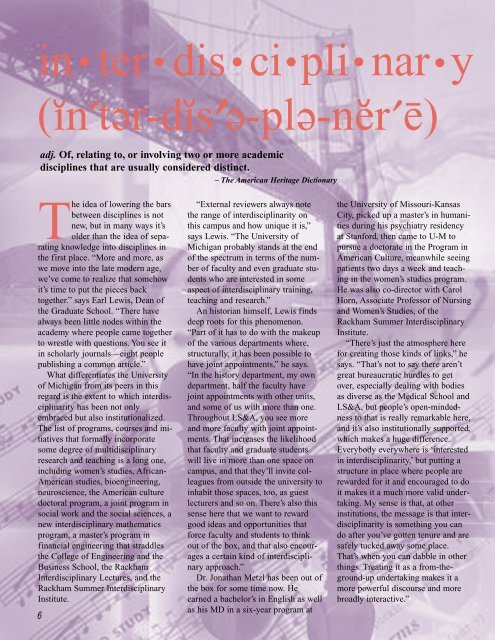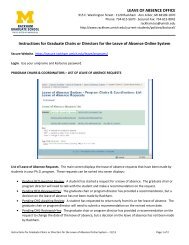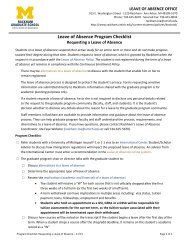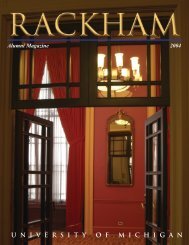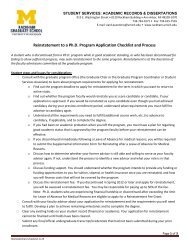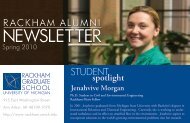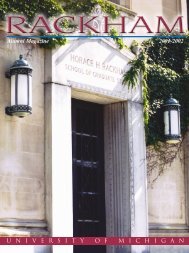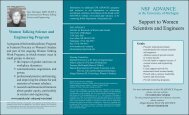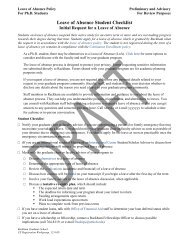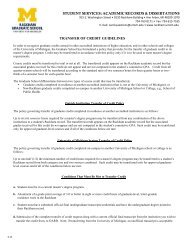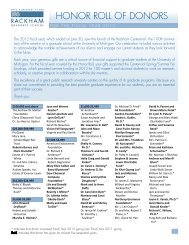adj. Of, relating to, or involving two or more academicdisciplines that are usually considered distinct.– The American Heritage DictionaryThe idea <strong>of</strong> lowering the barsbetween disciplines is notnew, but in many ways it’solder than the idea <strong>of</strong> separatingknowledge into disciplines inthe first place. “More and more, aswe move into the late modern age,we’ve come to realize that somehowit’s time to put the pieces backtogether.” says Earl Lewis, Dean <strong>of</strong>the <strong>Graduate</strong> <strong>School</strong>. “There havealways been little nodes within theacademy where people came togetherto wrestle with questions. You see itin scholarly journals—eight peoplepublishing a common article.”What differentiates the <strong>University</strong><strong>of</strong> <strong>Michigan</strong> from its peers in thisregard is the extent to which interdisciplinarityhas been not onlyembraced but also institutionalized.The list <strong>of</strong> programs, courses and initiativesthat formally incorporatesome degree <strong>of</strong> multidisciplinaryresearch and teaching is a long one,including women’s studies, African-American studies, bioengineering,neuroscience, the American culturedoctoral program, a joint program insocial work and the social sciences, anew interdisciplinary mathematicsprogram, a master’s program infinancial engineering that straddlesthe College <strong>of</strong> Engineering and theBusiness <strong>School</strong>, the <strong>Rackham</strong>Interdisciplinary Lectures, and the<strong>Rackham</strong> Summer InterdisciplinaryInstitute.6“External reviewers always notethe range <strong>of</strong> interdisciplinarity onthis campus and how unique it is,”says Lewis. “The <strong>University</strong> <strong>of</strong><strong>Michigan</strong> probably stands at the end<strong>of</strong> the spectrum in terms <strong>of</strong> the number<strong>of</strong> faculty and even graduate studentswho are interested in someaspect <strong>of</strong> interdisciplinary training,teaching and research.”An historian himself, Lewis findsdeep roots for this phenomenon.“Part <strong>of</strong> it has to do with the makeup<strong>of</strong> the various departments where,structurally, it has been possible tohave joint appointments,” he says.“In the history department, my owndepartment, half the faculty havejoint appointments with other units,and some <strong>of</strong> us with more than one.Throughout LS&A, you see moreand more faculty with joint appointments.That increases the likelihoodthat faculty and graduate studentswill live in more than one space oncampus, and that they’ll invite colleaguesfrom outside the university toinhabit those spaces, too, as guestlecturers and so on. There’s also thissense here that we want to rewardgood ideas and opportunities thatforce faculty and students to thinkout <strong>of</strong> the box, and that also encouragesa certain kind <strong>of</strong> interdisciplinaryapproach.”Dr. Jonathan Metzl has been out <strong>of</strong>the box for some time now. Heearned a bachelor’s in English as wellas his MD in a six-year program atthe <strong>University</strong> <strong>of</strong> Missouri-KansasCity, picked up a master’s in humanitiesduring his psychiatry residencyat Stanford, then came to U-M topursue a doctorate in the Program inAmerican Culture, meanwhile seeingpatients two days a week and teachingin the women’s studies program.He was also co-director with CarolHorn, Associate Pr<strong>of</strong>essor <strong>of</strong> Nursingand Women’s Studies, <strong>of</strong> the<strong>Rackham</strong> Summer InterdisciplinaryInstitute.“There’s just the atmosphere herefor creating those kinds <strong>of</strong> links,” hesays. “That’s not to say there aren’tgreat bureaucratic hurdles to getover, especially dealing with bodiesas diverse as the Medical <strong>School</strong> andLS&A, but people’s open-mindednessto that is really remarkable here,and it’s also institutionally supported,which makes a huge difference.Everybody everywhere is ‘interestedin interdisciplinarity,’ but putting astructure in place where people arerewarded for it and encouraged to doit makes it a much more valid undertaking.My sense is that, at otherinstitutions, the message is that interdisciplinarityis something you cando after you’ve gotten tenure and aresafely tucked away some place.That’s when you can dabble in otherthings. Treating it as a from-theground-upundertaking makes it amore powerful discourse and morebroadly interactive.”
The institute he co-directed bothmodeled such activity and provided aplace, like Virginia Woolf’s A Room<strong>of</strong> One’s Own, where interdisciplinarityitself could be engaged.We were going to create a systemthat was free <strong>of</strong> hierarchy, but whenwe got together in a room, peoplewere aware <strong>of</strong> who was above whomon the ladder, or who was in a disciplinethat was ‘in’ in certain crowdsor better funded. Being able toaddress those differences and talkabout them in ways that were uncomfortablesometimes lets participantsunderstand why interdisciplinary isdifficult even though it is supported.And having a realistic sense <strong>of</strong> that isconducive to creating projects orawarenesses that are more likely to besuccessful.”Elizabeth Wingrove, AssistantPr<strong>of</strong>essor <strong>of</strong> Political Science, wasone <strong>of</strong> 19 faculty members (alongwith four postdoctoral scholars and11 graduate students) who were institutefellows. Each was asked to participatein a small working group,one <strong>of</strong> whose charges was to plan atleast one event for the <strong>University</strong> andgeneral communities. Wingrove’sgroup included representatives <strong>of</strong>English, biology, history, pharmacologyand obstetrics/gynecology, andshe describes her ongoing relationshipswith them, as well as being“part <strong>of</strong> the constituent audience” forother groups’ projects, as “sort <strong>of</strong> thegift that keeps on giving.”“A great thing that came out <strong>of</strong> itwas the opportunity to meet people Iwould not otherwise have met, and tothink <strong>of</strong> them as resources for bothteaching and research that I hadn’tknown before,” she says. “Chattingwith folks in kinesiology, nursing, thelife sciences, was an amazing thing tobe able to do, even though it was notalways easy.”But, for Wingrove and her colleagues,it was the point. “I’ve cometo realize I need structural, institutionalsupport—time, money, accessto people—to do what I thought Iwas doing fairly well on my own,”she says. “I need to talk to folks whoactually do work in medical research,who work in policy oriented work,and certainly historians. I could listthem all, but the point is that when Ifirst heard about the Institute, Ithought not only was the theme[‘Disciplinary and InterdisciplinaryApproaches to the Body: From Cellto Self’] interesting and right onpoint with what I do in my research,but this would also be an opportunityto meet these people every day andtalk to them.”One <strong>of</strong> them, a colleague <strong>of</strong>Wingrove’s in their project group, isGina Bloom, who is nearing her doctoratein English and is also in thewomen’s studies certificate program.Although it certainly wasn’t part <strong>of</strong>the Institute’s formal syllabus, “I’mhelping Liz with some editing,” shesays. “I met her through the Institute.One <strong>of</strong> the nice things that emergedfrom that is getting to meet somepeople. As a grad student, it’s sometimestough to meet pr<strong>of</strong>essors outsideyour department.”Gabriela Frank is a pianist anddoctoral candidate in music theoryand composition. She, too, wasmoved to apply for the Institute bythe opportunity to build upon theinterdisciplinary foundation shehad already laid. “One <strong>of</strong> my specialtiesis South American music,”she says, “and I did some scholarlywork with some <strong>of</strong> the pr<strong>of</strong>essorshere, reading a lot <strong>of</strong> the writersand poets and learning about thepolitical history <strong>of</strong> South America.I’m also very interested in howbrain science relates to music. I’mpartially deaf myself, and I’vealways wondered about Beethovenand his deafness and how thataffected his music.”Choosing the human body as atheme for an interdisciplinary instituteseems to have been a tellingstroke. “The discipline <strong>of</strong> music centersaround the body,” says Frank.“You have to be able to master yourbody to master the instrument. I wasthe only musician participating thissummer and it was wonderful. Icould draw connections to whateveryone was doing. That’s what getsinteresting, when you have peoplewho are experts in different fieldslooking at the same thing and <strong>of</strong>feringdifferent explanations. I hadopportunities to talk to very intelligentpeople at the <strong>University</strong> <strong>of</strong><strong>Michigan</strong> who are not musicians. Ihad to retrain myself. I couldn’t talkabout fingerings because it wouldn’tmean anything.”But this is far from the end-gamefor the idea <strong>of</strong> disciplines. Perhapsironically, the concept <strong>of</strong> interdisciplinaritymight not only strengthenand refine disciplines but also itselftake on some <strong>of</strong> their characteristics.“I don’t believe disciplines are goingto disappear at all,” says Lewis. “Ithink interdisciplinarity will becomethe connective tissue that makes itmore sensible for disciplines to exist.“There is a training in learning abody <strong>of</strong> knowledge and a point <strong>of</strong>view that is incredibly important inentering into any academic discussion,”says Metzl. “The counterpointis that interdisciplinarity itselfbecomes disciplinary by the nature <strong>of</strong>institutions and funding. But at thesame time, if that new disciplinarystructure encourages people to thinkabout different perspectives inaddressing any number <strong>of</strong> problems,that seems like a pretty good thing.” ■7


